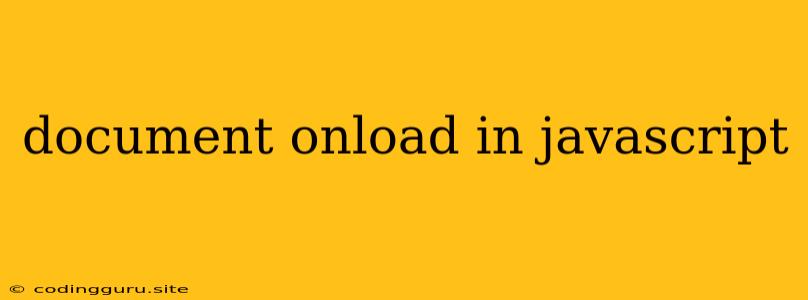Document onload in JavaScript: When and How to Use It
In the realm of web development, JavaScript plays a crucial role in enhancing user interactions and creating dynamic web pages. One fundamental aspect of JavaScript that developers often encounter is the document onload event. This event triggers a specific function when the entire HTML document, including all its embedded resources like images and scripts, has finished loading.
But why is document onload so important? What are its applications? And how can you effectively implement it in your JavaScript code? Let's delve into these questions to gain a comprehensive understanding of document onload.
Why Use document onload?
Imagine a scenario where you have a JavaScript code snippet designed to manipulate elements within your webpage. If you execute this code before the HTML document has fully loaded, the JavaScript might encounter errors because the elements it aims to target might not exist yet.
document onload comes to the rescue by ensuring that your JavaScript code only executes after the entire document has been loaded. This prevents potential errors and ensures that your scripts interact with the webpage as intended.
How to Implement document onload
You can utilize document onload in two primary ways:
1. Using the onload Event Handler
The most common and straightforward approach is to attach the onload event handler to the window object:
window.onload = function() {
// Your JavaScript code to be executed after the document loads
console.log("The document has finished loading!");
};
In this code, the function assigned to window.onload will be executed once the entire HTML document has finished loading.
2. Using addEventListener
Alternatively, you can use the addEventListener method to attach an event listener to the load event of the window object:
window.addEventListener("load", function() {
// Your JavaScript code to be executed after the document loads
console.log("The document has finished loading!");
});
This approach offers more flexibility and allows you to attach multiple event listeners for the same event, if needed.
Examples of Document onload Usage
Here are some common scenarios where document onload proves to be particularly helpful:
-
Manipulating DOM Elements: You can use document onload to ensure that your JavaScript code can access and modify elements in the HTML document after they have been fully loaded.
window.onload = function() { const myElement = document.getElementById("myElement"); myElement.style.color = "red"; }; -
Dynamically Adding Content: document onload allows you to dynamically add content to your webpage after it has finished loading.
window.onload = function() { const newParagraph = document.createElement("p"); newParagraph.textContent = "This paragraph is added dynamically!"; document.body.appendChild(newParagraph); }; -
Handling AJAX Requests: If you need to make AJAX requests to fetch data from external sources, it's often beneficial to execute these requests after the document has loaded.
window.onload = function() { const xhr = new XMLHttpRequest(); xhr.open("GET", "https://example.com/data.json"); xhr.onload = function() { if (xhr.status >= 200 && xhr.status < 400) { const data = JSON.parse(xhr.responseText); // Process the fetched data } }; xhr.send(); };
Alternative Approaches for Executing Code after Document Load
While document onload is a reliable approach, there are alternative methods for executing JavaScript code after the document has loaded. These include:
-
DOMContentLoadedEvent: This event is fired as soon as the HTML document has been parsed, even before external resources like images and stylesheets have finished loading. It is a good choice when you only need to interact with the DOM structure and not external resources.document.addEventListener("DOMContentLoaded", function() { console.log("DOM has been loaded!"); }); -
Using
deferAttribute for Scripts: You can add thedeferattribute to your<script>tags. This ensures that the scripts are executed after the HTML document has been parsed, but before theloadevent occurs.
Conclusion
The document onload event is an essential tool in a web developer's arsenal. By ensuring that your JavaScript code executes only after the entire HTML document has loaded, you avoid potential errors and create a smoother user experience. While alternative approaches like DOMContentLoaded and the defer attribute offer additional flexibility, document onload remains a fundamental and reliable way to execute JavaScript code at the appropriate time.
